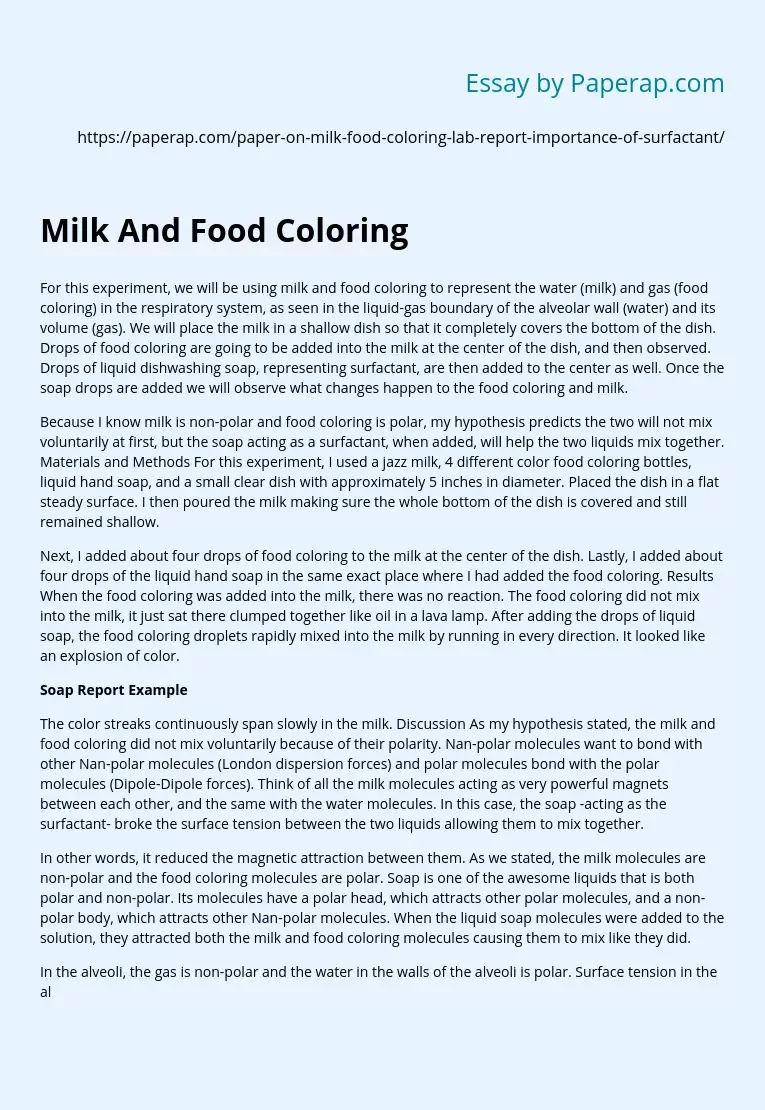For this experiment, we will be using milk and food coloring to represent the water (milk) and gas (food coloring) in the respiratory system, as seen in the liquid-gas boundary of the alveolar wall (water) and its volume (gas). We will place the milk in a shallow dish so that it completely covers the bottom of the dish. Drops of food coloring are going to be added into the milk at the center of the dish, and then observed. Drops of liquid dishwashing soap, representing surfactant, are then added to the center as well.
Once the soap drops are added we will observe what changes happen to the food coloring and milk.
Because I know milk is non-polar and food coloring is polar, my hypothesis predicts the two will not mix voluntarily at first, but the soap acting as a surfactant, when added, will help the two liquids mix together. Materials and Methods For this experiment, I used a jazz milk, 4 different color food coloring bottles, liquid hand soap, and a small clear dish with approximately 5 inches in diameter.
Placed the dish in a flat steady surface. I then poured the milk making sure the whole bottom of the dish is covered and still remained shallow.
Next, I added about four drops of food coloring to the milk at the center of the dish. Lastly, I added about four drops of the liquid hand soap in the same exact place where I had added the food coloring. Results When the food coloring was added into the milk, there was no reaction.
The food coloring did not mix into the milk, it just sat there clumped together like oil in a lava lamp. After adding the drops of liquid soap, the food coloring droplets rapidly mixed into the milk by running in every direction. It looked like an explosion of color.
The color streaks continuously span slowly in the milk. Discussion As my hypothesis stated, the milk and food coloring did not mix voluntarily because of their polarity. Nan-polar molecules want to bond with other Nan-polar molecules (London dispersion forces) and polar molecules bond with the polar molecules (Dipole-Dipole forces). Think of all the milk molecules acting as very powerful magnets between each other, and the same with the water molecules. In this case, the soap -acting as the surfactant- broke the surface tension between the two liquids allowing them to mix together.
In other words, it reduced the magnetic attraction between them. As we stated, the milk molecules are non-polar and the food coloring molecules are polar. Soap is one of the awesome liquids that is both polar and non-polar. Its molecules have a polar head, which attracts other polar molecules, and a non-polar body, which attracts other Nan-polar molecules. When the liquid soap molecules were added to the solution, they attracted both the milk and food coloring molecules causing them to mix like they did.
In the alveoli, the gas is non-polar and the water in the walls of the alveoli is polar. Surface tension in the alveoli is very high because of the liquid/gas boundary. This surface tension draws the liquid molecules closer together and reduces their contact with the gas molecules; this way the alveoli do not collapse. The water in the walls of the alveoli help the alveolar walls come together during exhalation (when the oxygen leaves the alveoli), so that they stick together and allow the alveoli to reach their smallest size.
The surfactant that is secreted aids the walls to be able to come together, but not with the attraction of their potential because it’s too strong. If they came together with their normal attraction, the walls would stick together and their strong surface tension would not allow them to unstuck. A collapsed alveolar will have to be completely re- inflated during each inspiration, which takes a lot of energy to do. With the surfactant, during inhalation the incoming gas is able to split the walls open because their attraction is not as strong.
This way, the walls are able to come apart easier and make more space for the oxygen that fills up the alveoli. If our alveolar cells did not produce surfactant whatsoever, breathing would be very hard. Each inhalation would not have the easy flow it has now; it would take a lot of energy and not to mention be tougher. Conclusion Just like the water and gas in our lungs, the milk and food coloring would not have been able to mix. Both the liquid soap and the surfactant reduce the genetic force that unites liquid molecules- in this case allowing milk and food coloring to mix.
Milk And Food Coloring Report Example. (2019, Dec 05). Retrieved from https://paperap.com/paper-on-milk-food-coloring-lab-report-importance-of-surfactant/

